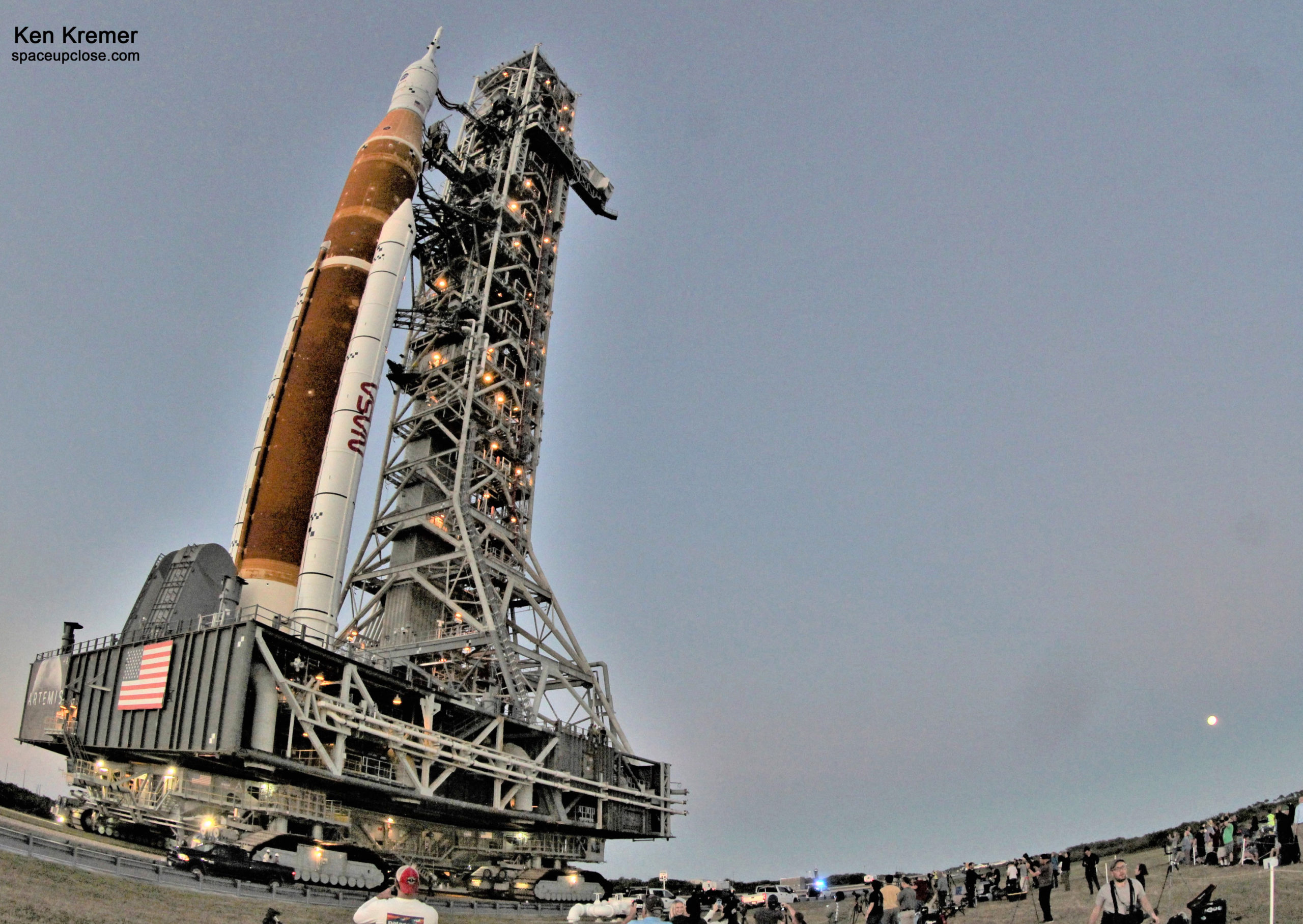
For SpaceUpClose.com & RocketSTEM
KENNEDY SPACE CENTER, FL – NASA’s maiden Space Launch System (SLS) Mega Moon rocket has rolled out in stunning fashion from the iconic Vehicle Assembly Building (VAB) on a spectacular 4 mile trip to the launchpad at the Kennedy Space Center (KSC) – with its lunar objective for the Orion deep space crew capsule movingly visible as moonrise at sunset- for the first time, Thursday, March 17, where it will remain several weeks to undergo a critical countdown fueling test in early April and eventually launch on the history-making, unpiloted Artemis 1 lunar mission as soon as June.
NASA’s SLS rocket stacked with the Orion spacecraft integrated atop the crawler-transporter-2 (CT-2) arrived at Launch Pad 39B at KSC in Florida, Friday, March 18 in preparation for its final test – the Wet Dress Rehearsal (WDR) countdown and fueling test before liftoff on the Artemis I Moon mission.
Overall the momentous trip along the crawlerway that previously hosted NASA’s Saturn V and Space Shuttle rockets took 10-hours and 28 minutes for SLS and Orion to reach the launch pad four miles (6.8 km) away
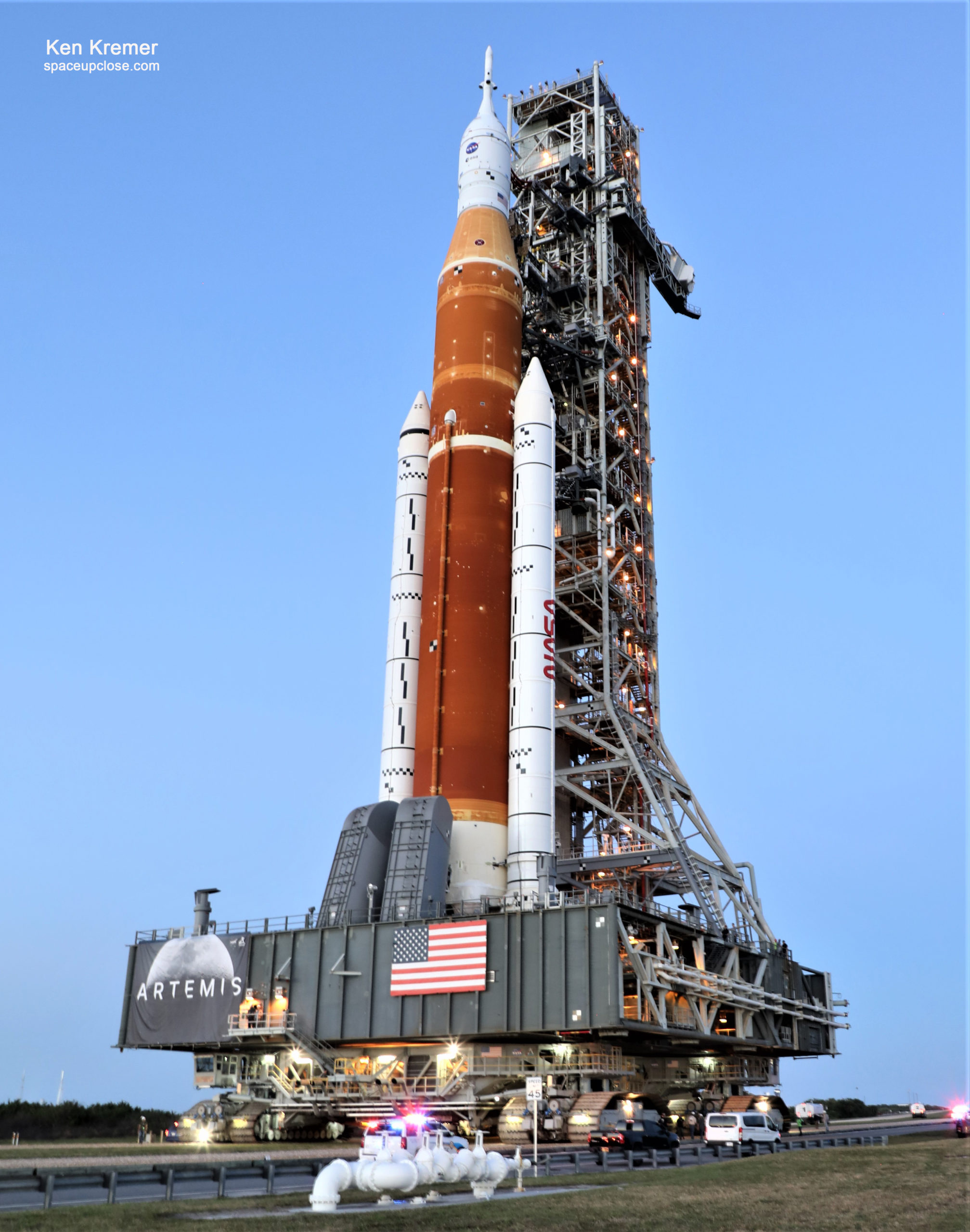
Stacked on the mobile launcher and mounted on the crawler-transporter-2 (CT-2) for a journey from the Vehicle Assembly Building to Launch Pad 39B, it took 10-hours and 28 minutes for the 3.5-million-pound SLS and Orion to arrive at the launch pad four miles (6.8 km) away.
10 hours and 28 minutes.
That’s how long it took for the crawler to arrive at the launchpad with the 3.5-million-pound @NASA_SLS rocket and @NASA_Orion spacecraft.
Now, @NASAKennedy teams are preparing for one final test before liftoff of #Artemis I. https://t.co/q0lL6Zlxzr pic.twitter.com/Y3Ch3pnTp2
— NASA Artemis (@NASAArtemis) March 18, 2022
It was near sunset when the stack was finally outside the VAB and at last fully on the move- greeted by a stark moonrise appropriate to the occasion since it’s the target of Project Artemis ‘Return to the Moon’ program.
The trip began with first motion at 5:47 p.m. EDT (2147 GMT) Thursday, March 17, and the 322-foot tall, 3.5-million-pound rocket and spacecraft departing the VAB and arriving at pad 39B at 4:15 a.m. EDT (0815 GMT) on Friday, March 18.
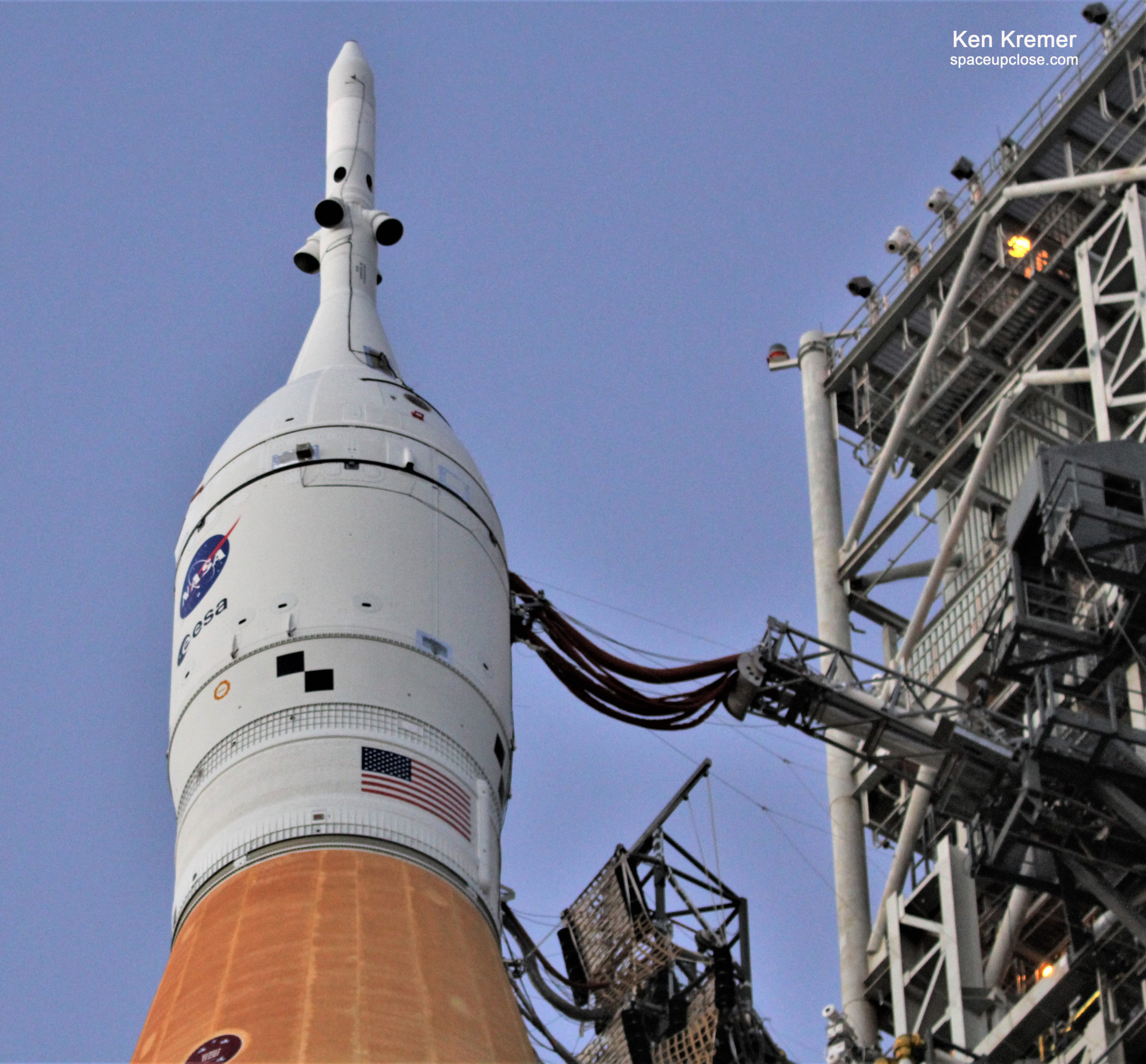
The upgraded crawler-transporter-2 (CT-2) originally built for NASA’s Apollo Moon landing program in the 1960s and 1970s moved the stack at a maximum speed of 0.82 mph (1.3 kph) toward the pad.
Years in the making NASA’s SLS Moon rocket is destined to return American astronauts to the lunar surface for the first time in over 50 years later this decade.
“From this sacred and historical place, humanity will soon embark on a new era of exploration,” said NASA administrator Bill Nelson.
“Artemis I will demonstrate NASA’s commitment and capacity to extend humanity’s presence on the Moon – and beyond.”
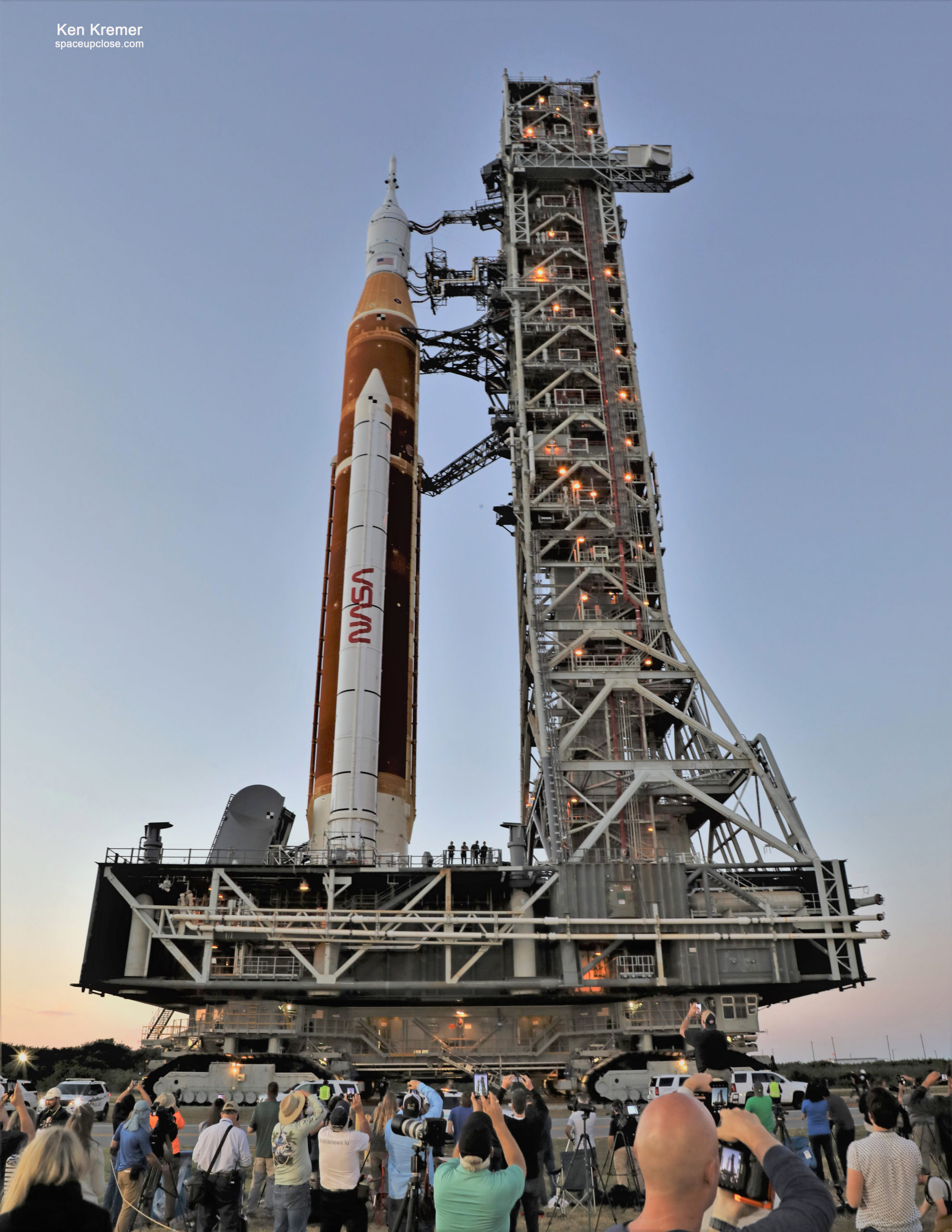
Just days earlier technicians retracted the last two work platforms surrounding the 32 story tall rocket inside the Vehicle Assembly Building (VAB) where its components have been assembled together over the past year.
The rollout was broadcast live on NASA TV starting around 5 p.m. EDT March 17 from KSC.
“At these launch pads, remarkable individuals achieve unthinkable things,” Administrator Nelson said during NASA’s live rollout broadcast at KSC.
“Today, a new generation — not the Apollo generation, but it’s the Artemis generation — is preparing to reach new frontiers. This generation will return astronauts to the moon, and this time, we will land the first woman and the first person of color on the surface to conduct groundbreaking science.”
“NASA’s Artemis program will pave the way for humanity’s giant leap — future missions to Mars,” Nelson added.
“There is no doubt we are in a golden era of human space exploration, discovery and ingenuity in space. And it all begins with Artemis 1.”
“Artemis 1 will demonstrate NASA’s commitment and capacity to extend humanity’s presence on the moon and beyond.”
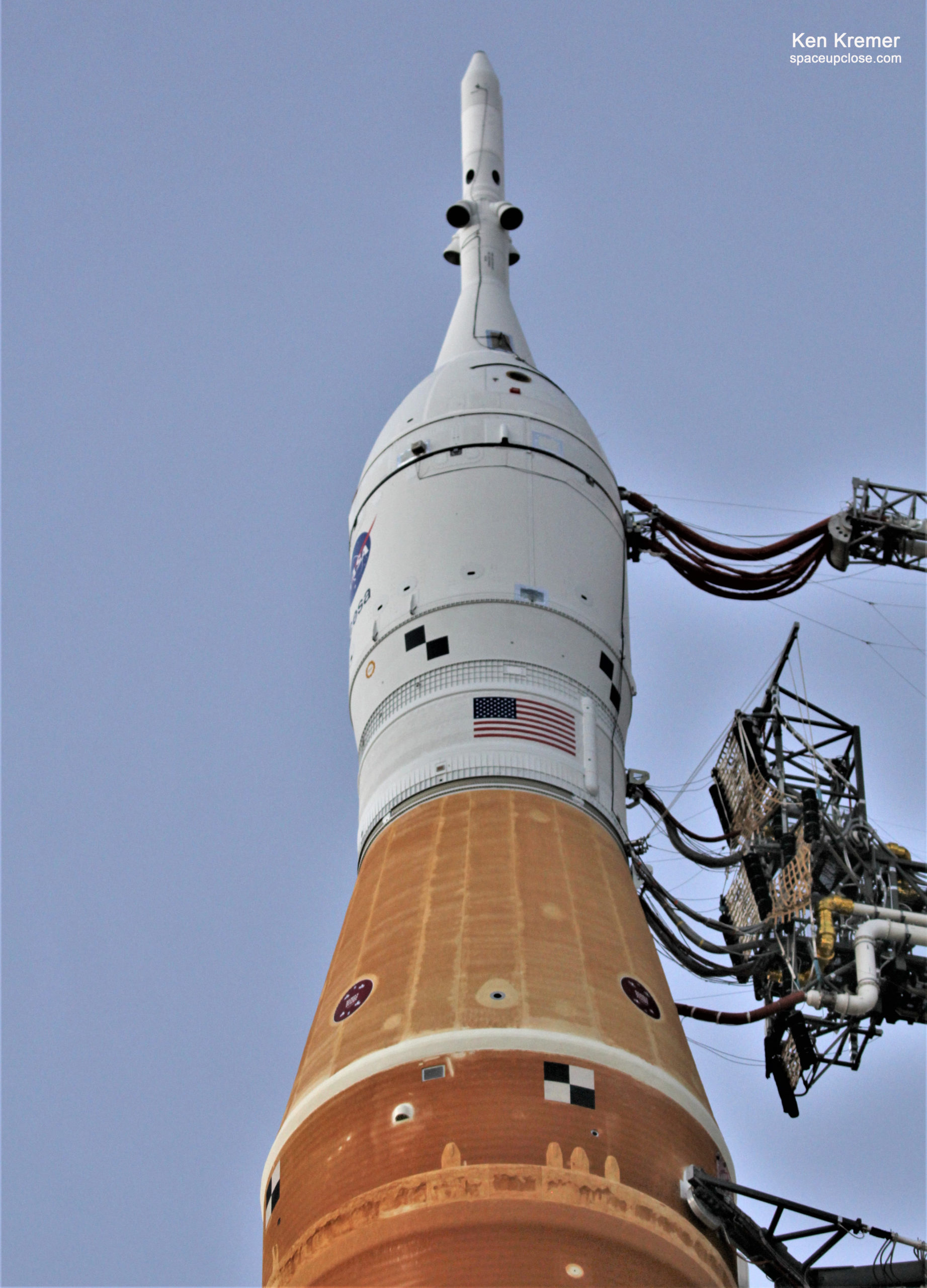
SLS is the most powerful rocket NASA has ever built, generating some 8.8 million pounds of liftoff thrust at ignition – about 15% more powerful than NASA’s legendary Saturn V that hurled the first humans to land on the Moon back in 1969 on the Apollo 11 moon landing mission.
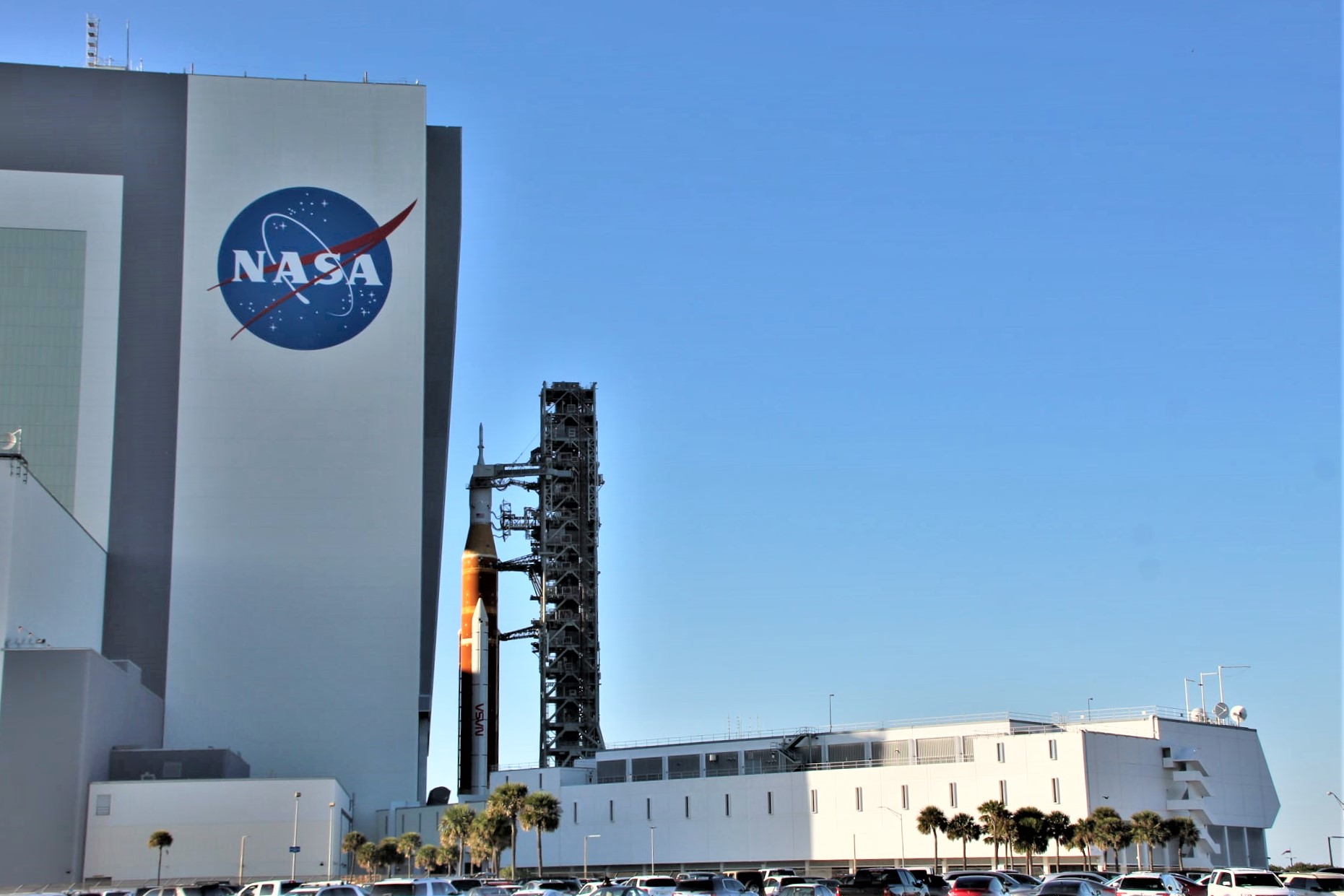
NASA’s iconic retro ‘Worm’ logo has been painted on the side of the upgraded 5 segment twin 177 foot tall Solid Rocket Boosters (SRB) that will provide most of the SLS rockets liftoff thrust.
The Space UpClose team of Ken Kremer and Jean Wright attended and witnessed the rollout from VAB at the KSC Press Site and OSB-2.
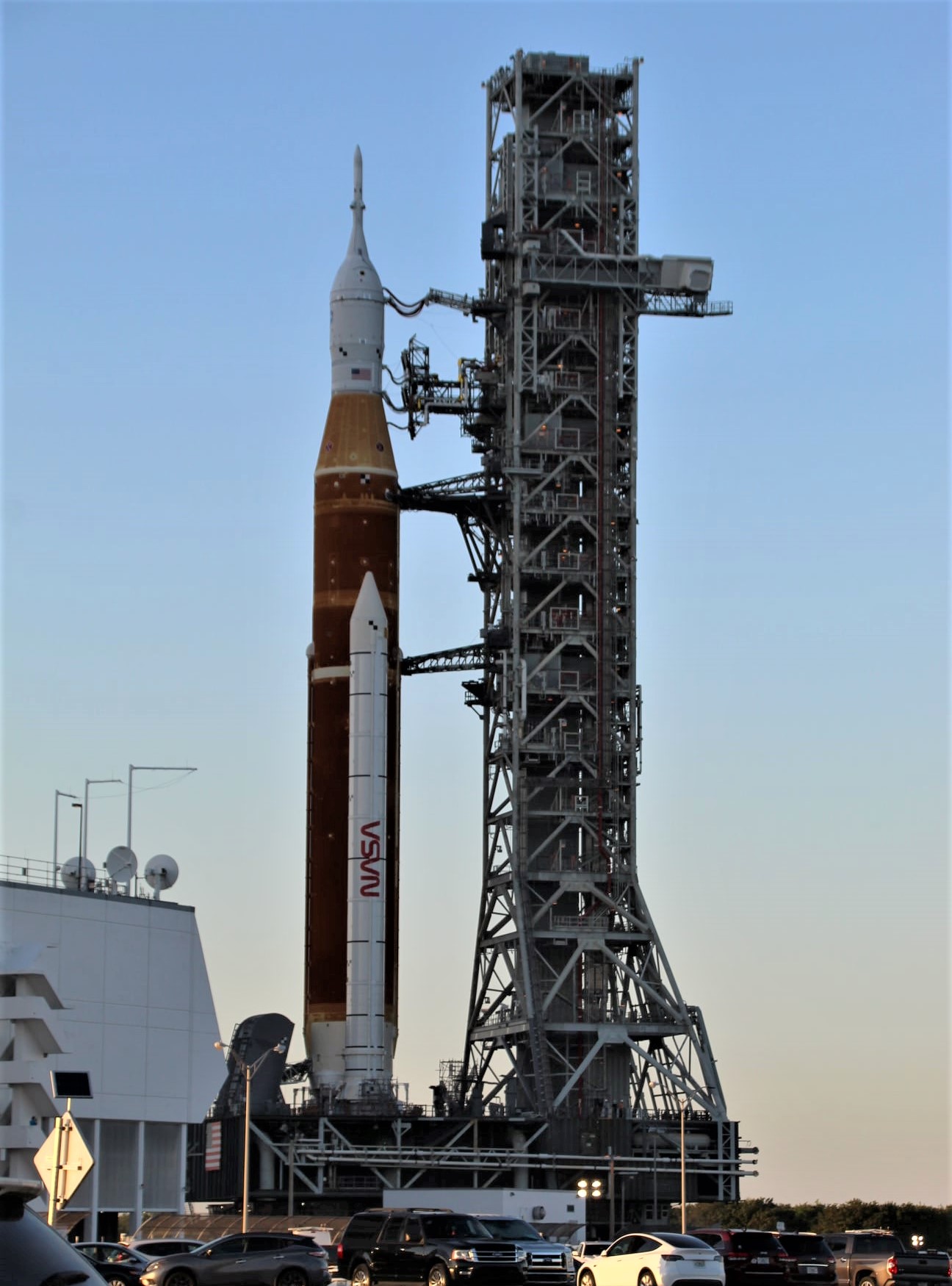
Enjoy our rollout photos and check back as we add more.
Now we know what NASA’s Apollo Moon rocket rollout looked like.
We both witnessed multiple Space Shuttle rollouts
SLS serves as the backbone of the Artemis program and the nation’s future deep space exploration missions.
Overall SLS stands 322 feet (98 meters) tall and weighs 5.75 million pounds.
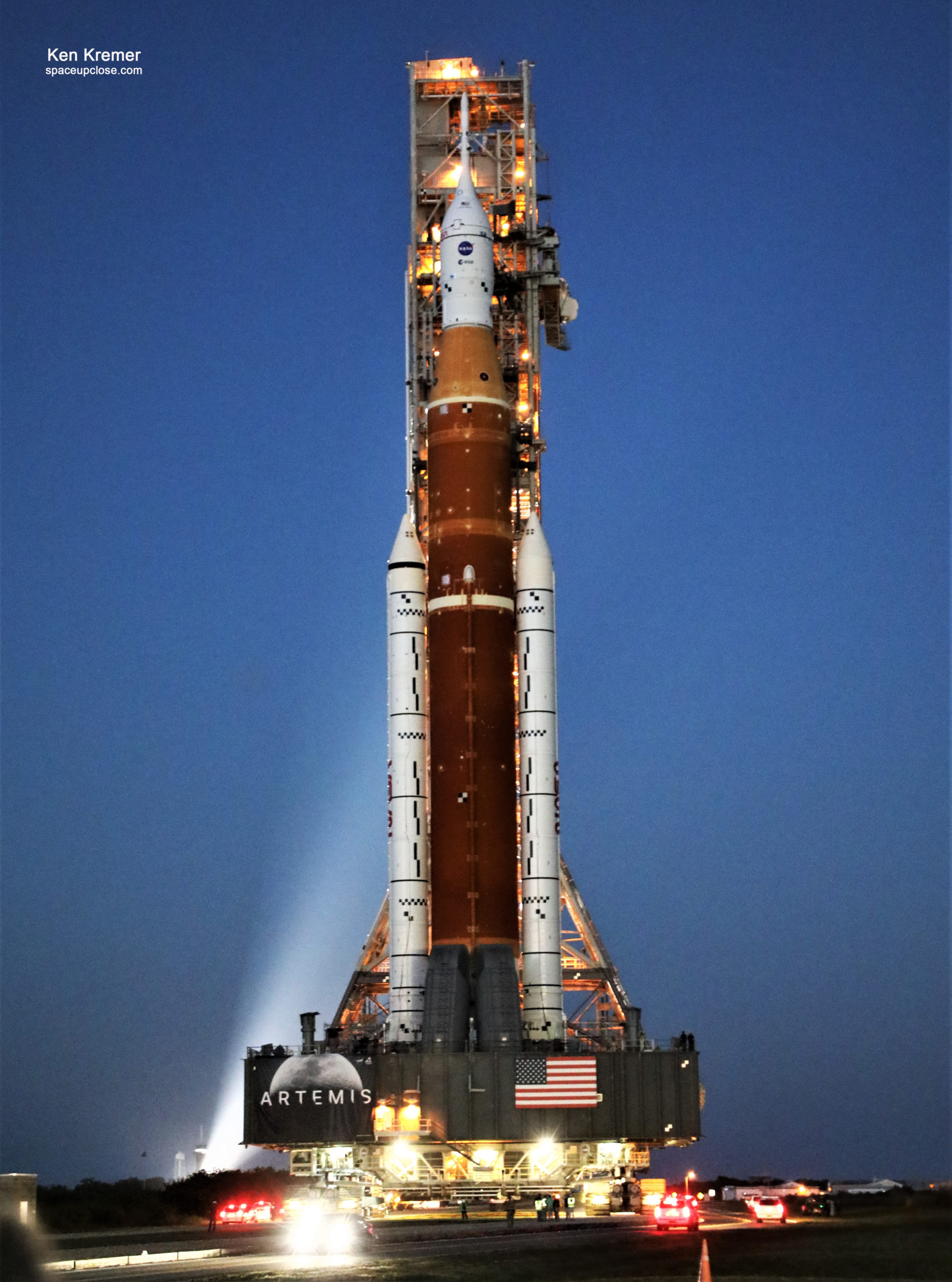
The uncrewed Artemis 1 flight test will pave the way for missions to land the first woman and first person of color on the Moon under Artemis as soon as 2025, and the rocket rolled to the pad Thursday for a critical final fueling test before launch.
“Rolling out of the Vehicle Assembly Building is an iconic moment for this rocket and spacecraft, and this is a key milestone for NASA,” said Tom Whitmeyer, deputy associate administrator for Common Exploration Systems Development at NASA Headquarters in Washington.
“Now at the pad for the first time, we will use the integrated systems to practice the launch countdown and load the rocket with the propellants it needs to send Orion on a lunar journey in preparation for launch.”
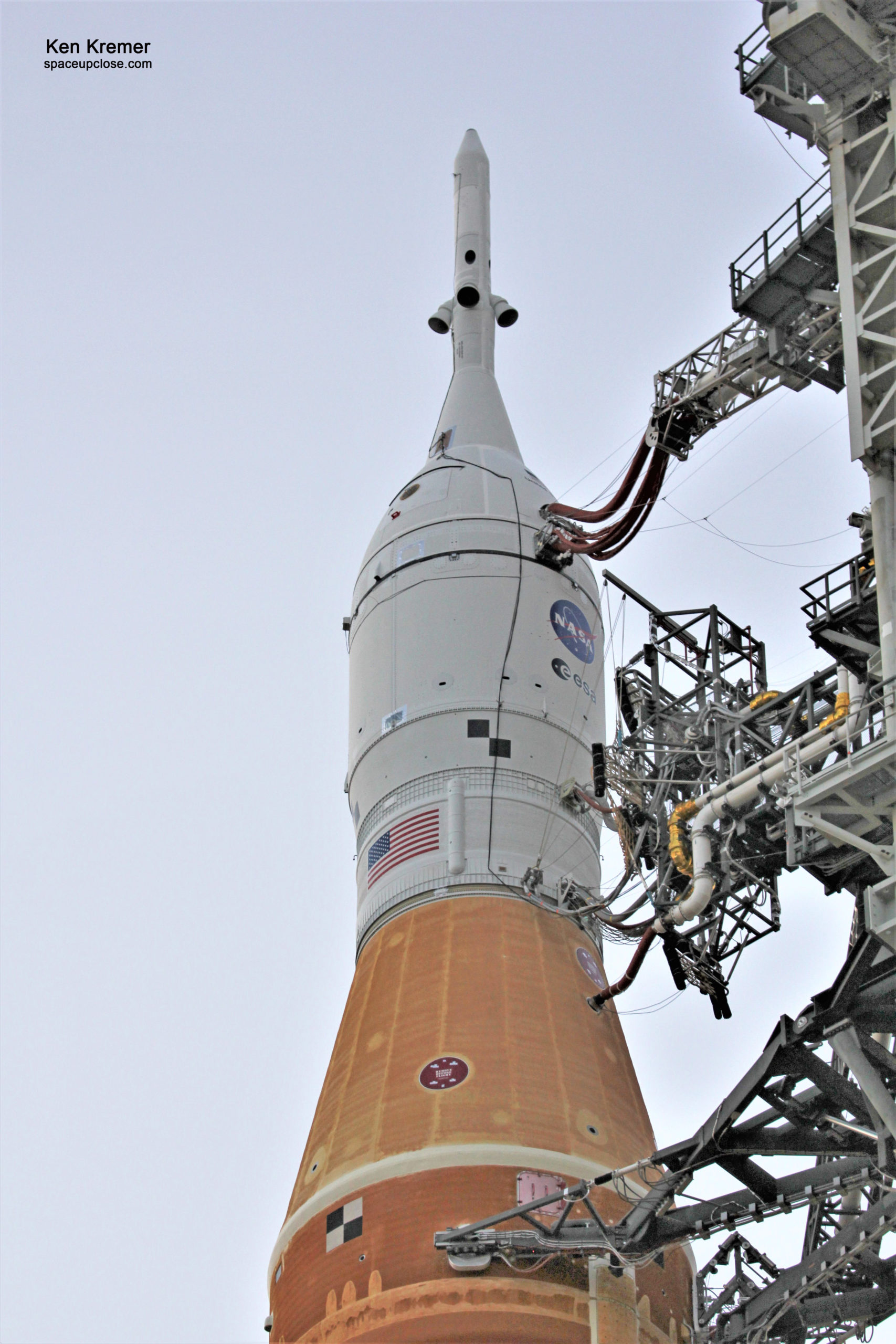
During the WDR the Artemis I launch team will “run through operations to load propellant into the rocket’s tanks, conduct a full launch countdown, demonstrate the ability to recycle the countdown clock, and also drain the tanks to practice the timelines and procedures the team will use for launch.”
The WDR is currently targeted for April 3. The call to stations is expected on April 1 for the 2 day test.
Both stages of SLS will be fueled during the WDR.
During the two ‘Green Run’ WDR tests conducted last year at NASA Stennis in 2021 only the core stage was fueled because the rocket was not yet stacked at that point.
So the test at KSC will be the first WDR of a fully stacked and integrated SLS and Orion.
The second stage called the ICPS or Interim Cryogenic Propulsion Stage is built by ULA.
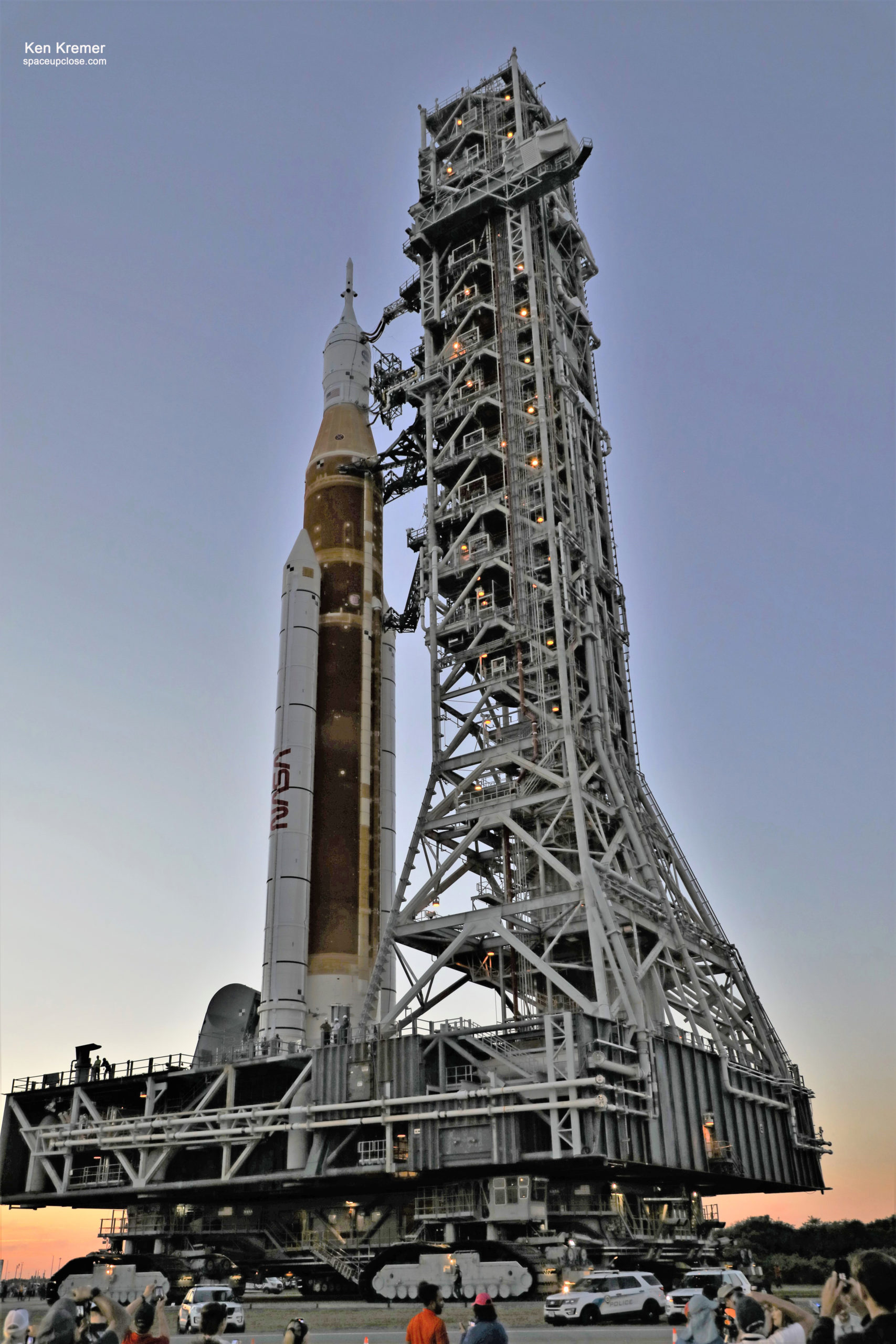
The propellant loading is expected to last about eight hours or so, said Charlie Blackwell-Thompson, Artemis launch director at NASA, at the March 14 media briefing.
By comparison NASA’s Space Shuttle from which SLS is derived took about two and a half hours. SLS is longer because it has an upper stage which must also be loaded with propellants, she noted.
The first stage will be fueled with cryogenic liquid oxygen (LOX) and liquid hydrogen (LH2) starting around 7 a.m. EDT (1100 GMT) on WDR test day.
The countdown dress rehearsal will proceed to the T Minus 10 second mark and then be intentionally aborted before engine ignition.
The WDR fueling test is the final major test before launch and a successful outcome is key to setting a launch target date for Artemis 1 – most likely NET June 2022.
“During the test at the launch pad, engineers will be on duty in the Launch Control Center and in other stations where they will work during the Artemis I launch. They will capture as much data as possible on the performance of all the systems that are part of SLS and the Orion spacecraft as well as the Kennedy ground systems. NASA will set a target launch date after a successful wet dress rehearsal test.”
After completing the WDR and the SLS rocket and spacecraft systems are verified the 322-foot-tall rocket will roll back into the VAB “for final inspections and checkouts, including the second part of the flight termination system test, ahead of returning to the pad for launch.”
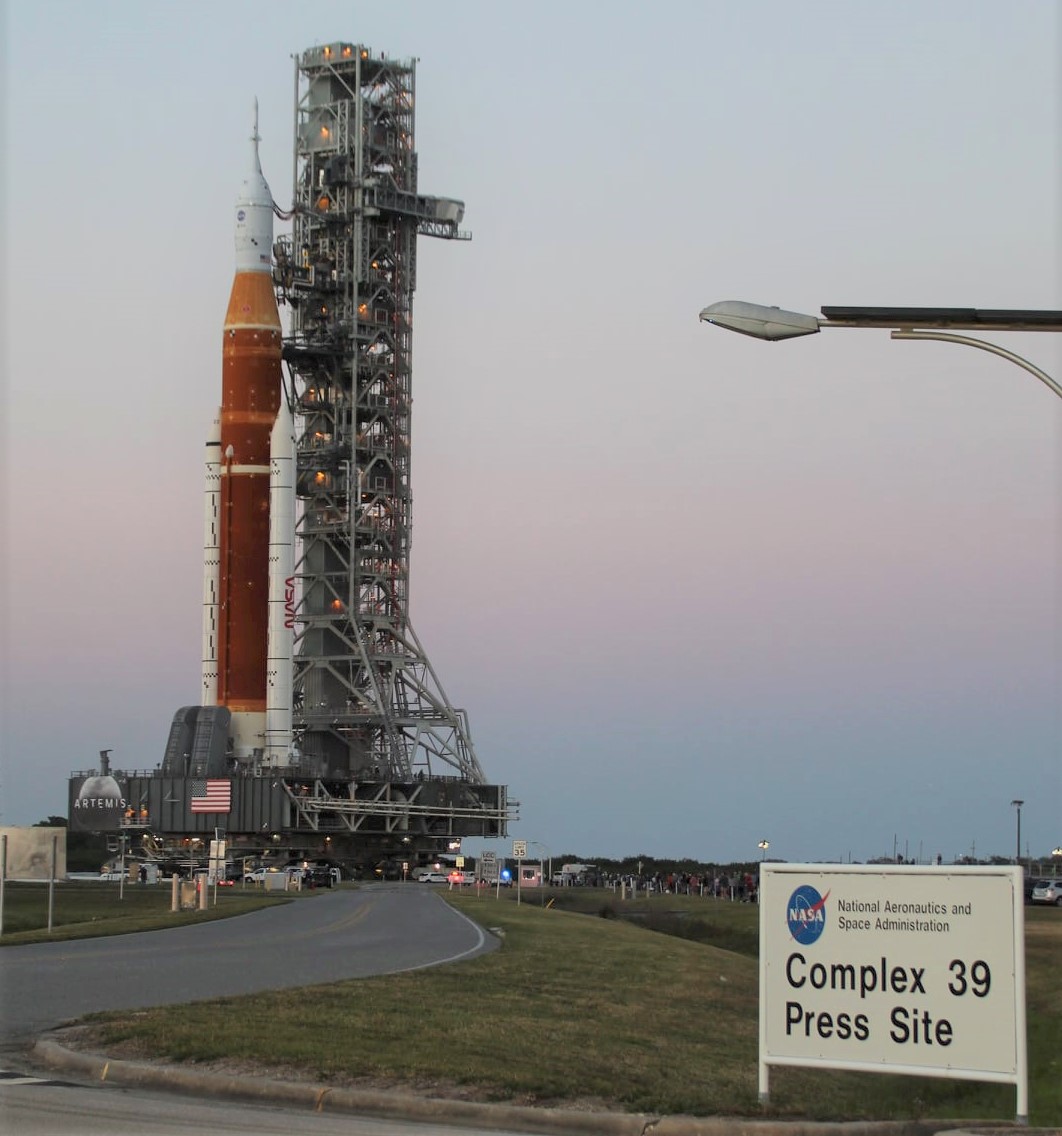
Liftoff of the uncrewed Artemis 1 mission is slated for no earlier than June 2022 from Launch Complex 39B at NASA KSC on the first in a series of increasingly complex missions to test the SLS heavy lift mega rocket and Orion crew capsule as an integrated system prior to crewed flights to the Moon starting with Artemis 2 – targeting launch in 2024.
SLS 1 will launch the Orion crew spacecraft on the Artemis 1 mission lasting between 4 to 6 weeks on a journey of some 280,000 miles (450,000 kilometers) from Earth to many thousands of miles past the moon and then return to Earth.
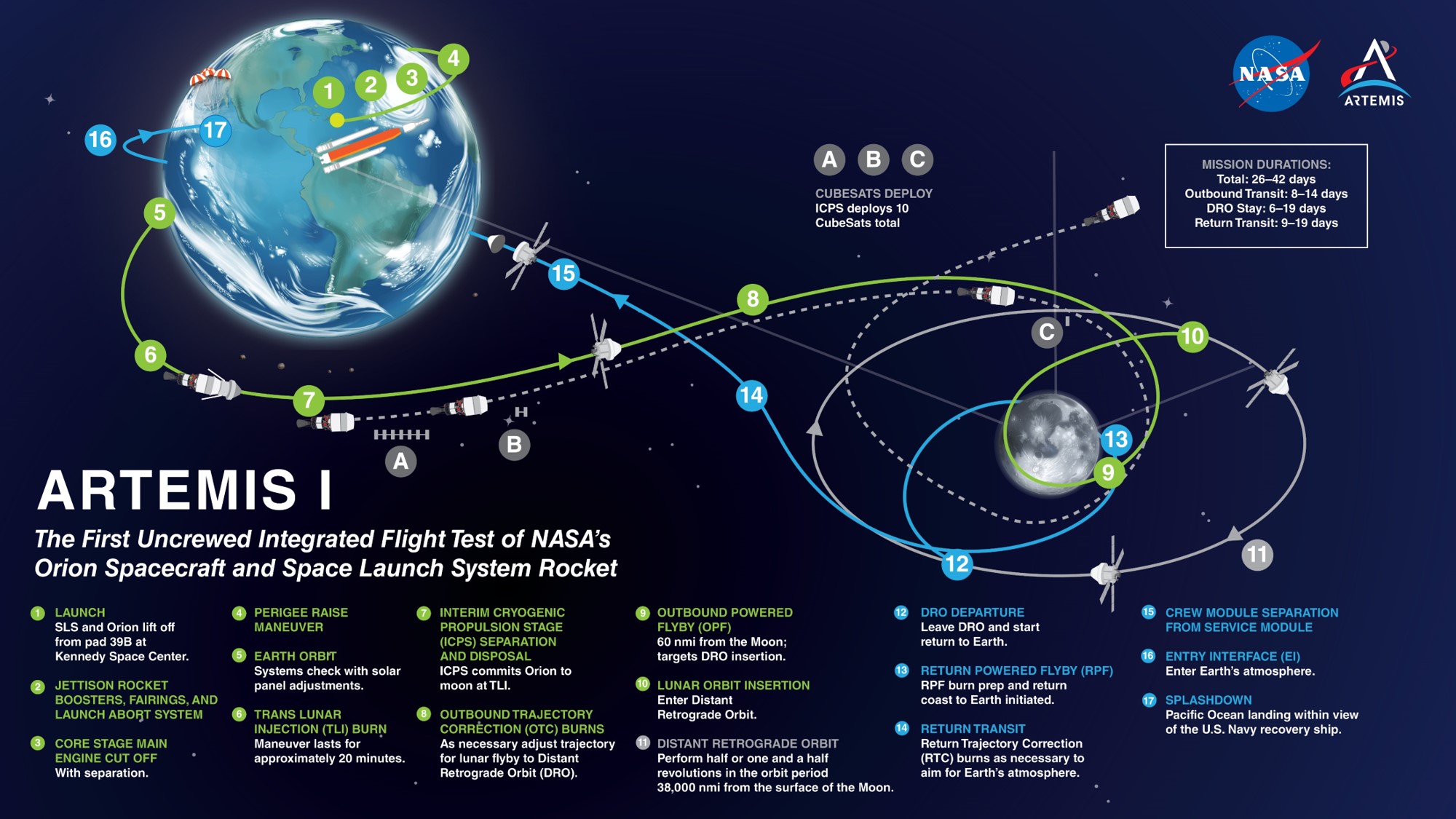
Then and now here’s NASA’s tweet comparing Saturn/Apollo stack and SLS/Orion Artemis stack
Then ➡️ Now
On the left, you’ll see the Saturn V rocket for the Apollo 14 mission leaving the Vehicle Assembly Building. On the right, you’ll find the #Artemis I Moon rocket leaving the same iconic building for its journey to Launch Complex 39B: https://t.co/mYCjKp2TYU pic.twitter.com/fm0Ct7nF4b
— NASA's Kennedy Space Center (@NASAKennedy) March 18, 2022
A crew of four NASA and Canadian astronauts will fly aboard Artemis 2 in 2024 in the Orion capsule on the first crewed mission to the Moon in more than 50 years
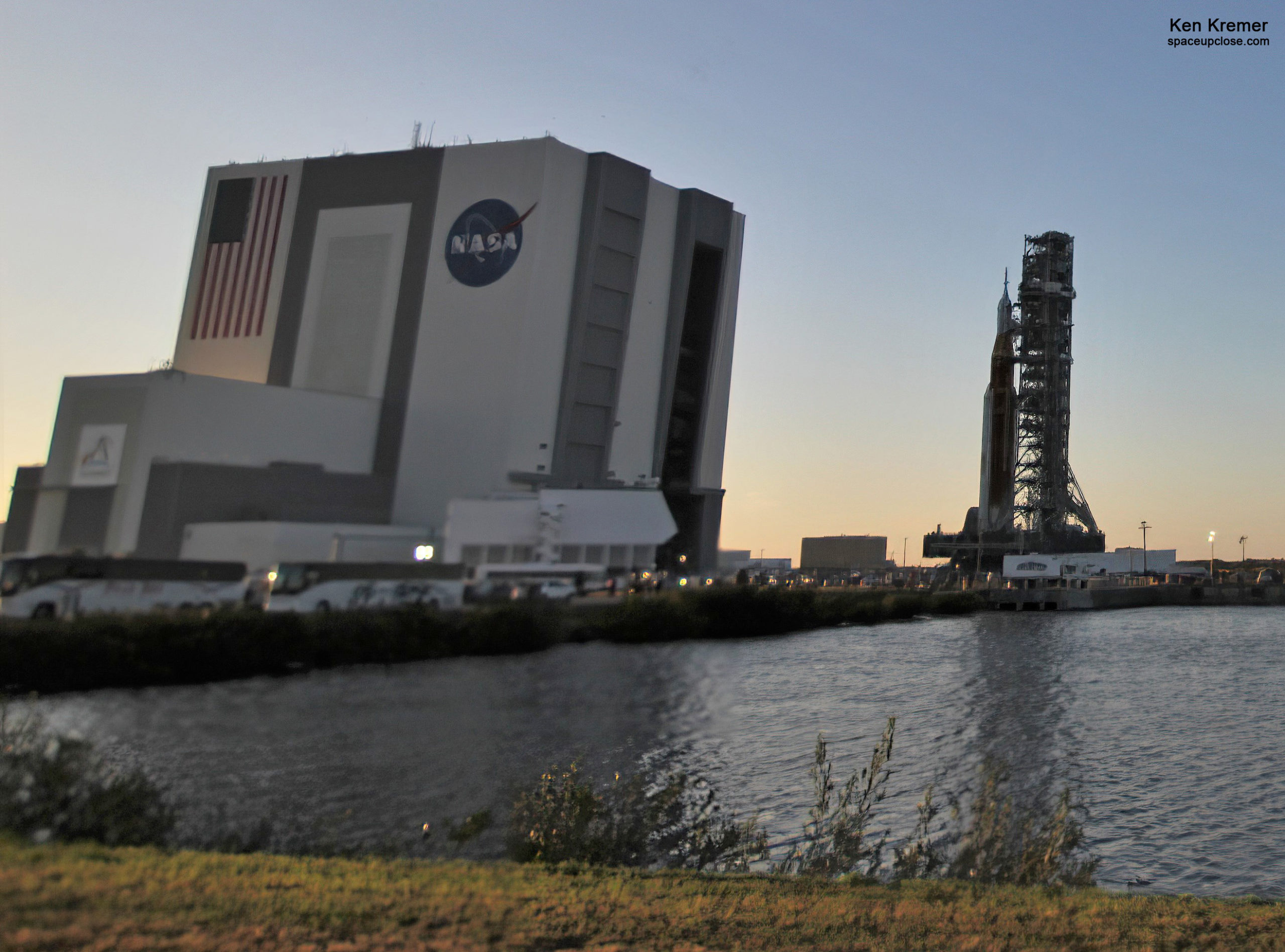
The SLS core stage measures 212 feet tall and 27.6 feet in diameter.
The bottom of SLS is equipped with four Aerojet-Rocketdyne built RS-25 engines fueled by over 730,000 gallons of cryogenic super cold LOX (liquid oxygen) and LH2 (liquid hydrogen) propellants to generate some 2 million pounds of liftoff thrust to help power the SLS rocket at launch.
SLS was built by prime contractor Boeing at NASA’s Michoud Assembly Facility in New Orleans.
Orion was built by prime contractor Lockheed Martin at the Kennedy Space Center.
The RS-25 engines are attached to the base of the core stage and are recycled from the Space Shuttle where they were reused and reflown numerous times.
Previously known as the Space Shuttle Main Engine, or SSME, they have been refurbished and upgraded in numerous ways including with a new ‘brain controller’ and can fire at 109% thrust.
This first SLS core stage arrived on NASA’s Pegasus barge April 27, 2021 and was then rolled off the barge and into VAB two days later on April 29, 2021 for the extensive stacking and preparatory operations for launch on the history making Artemis 1 mission to deliver NASA’s Orion deep space human rated capsule to the Moon.
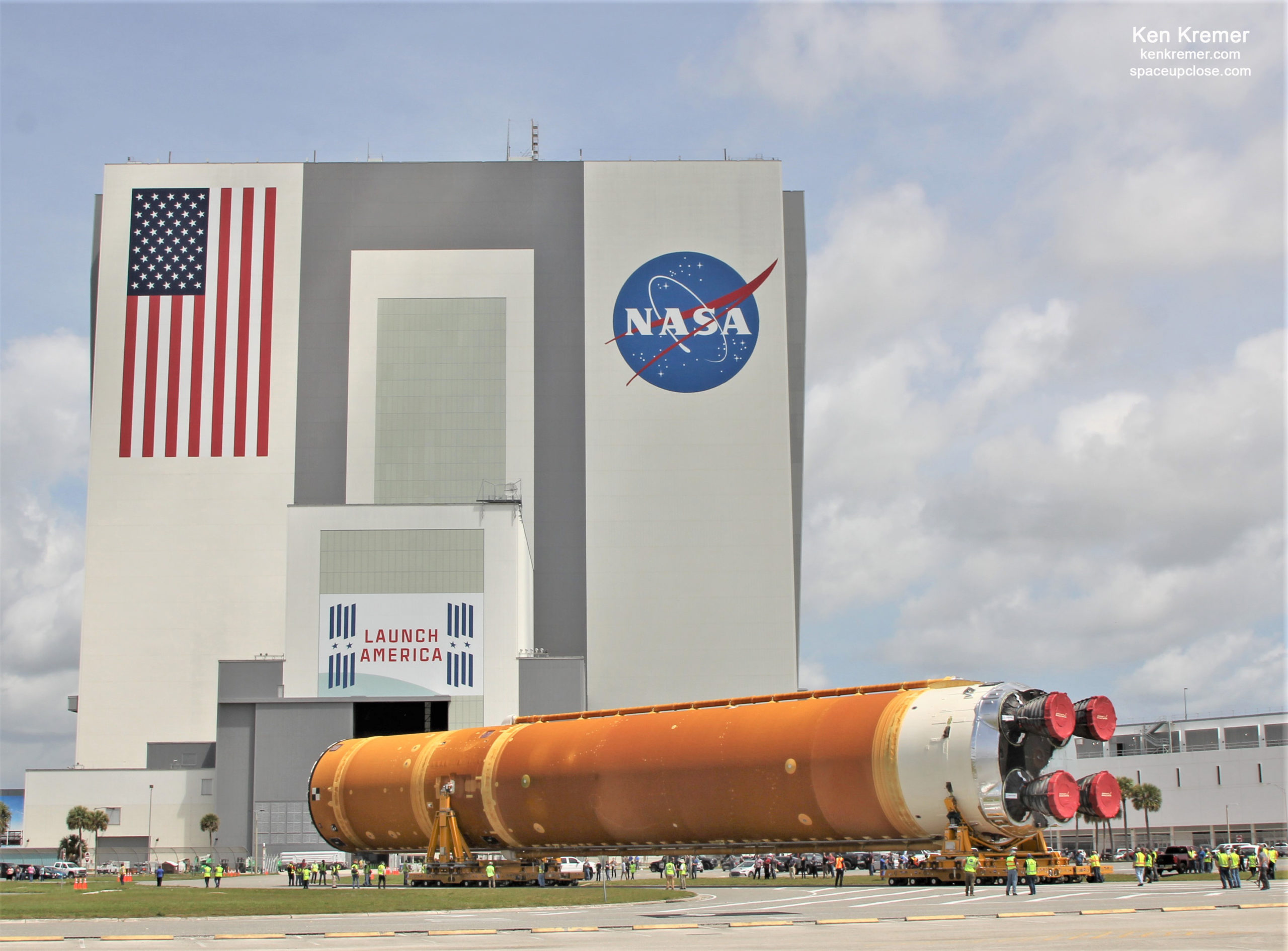
The SLS was assembled in High Bay 3 and the right side doors were opened late Thursday morning to expose the rocket for rollout to pad 39B.
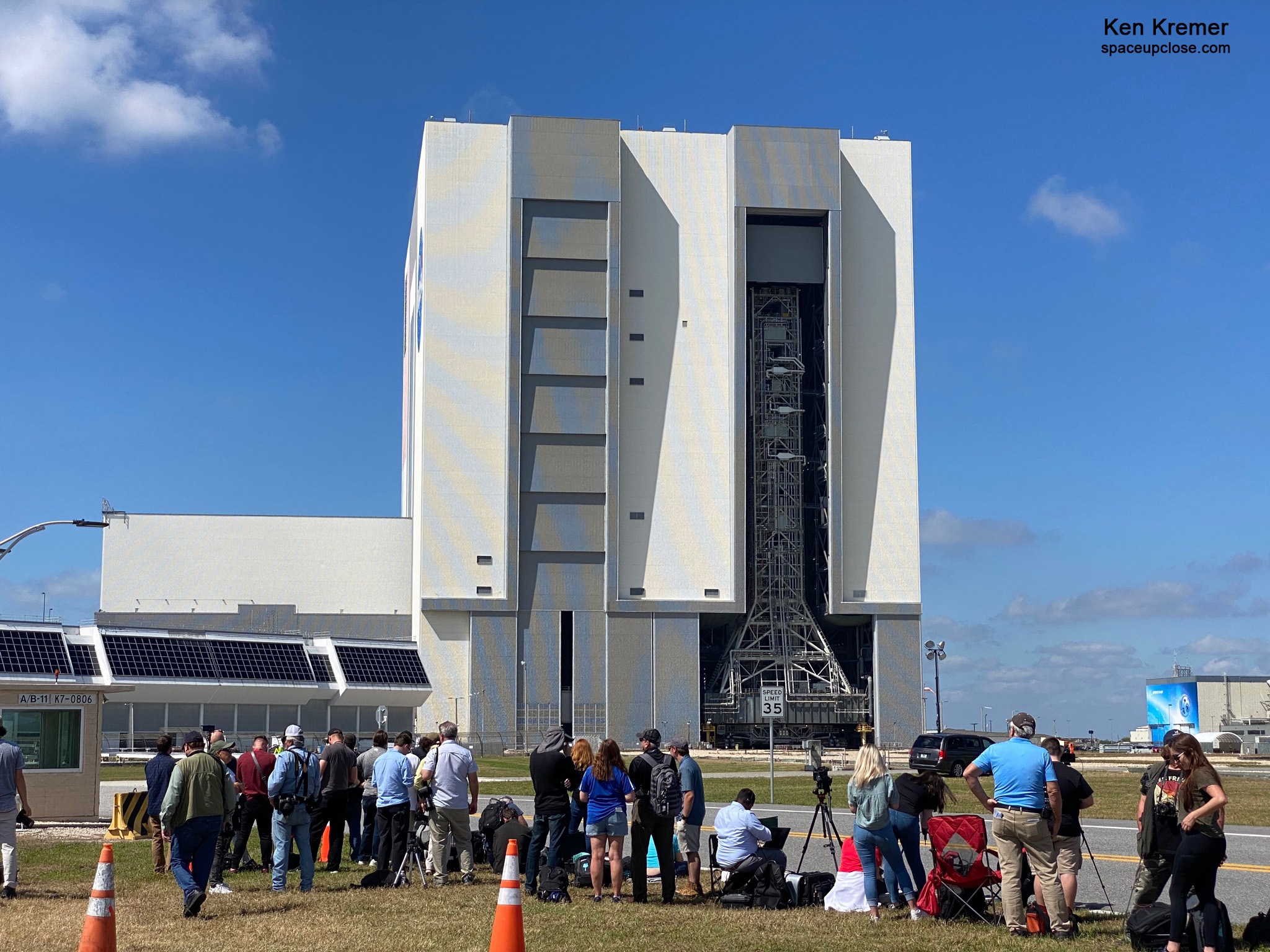
WFTV Channel 9 ABC News Orlando featured Ken‘s pre-rollout commentary about how critical NASA’s Space Launch System Artemis 1 launch to the Moon is to NASA – with 1st ever rocket rollout to pad 39B just completed at NASA’s Kennedy Space Center
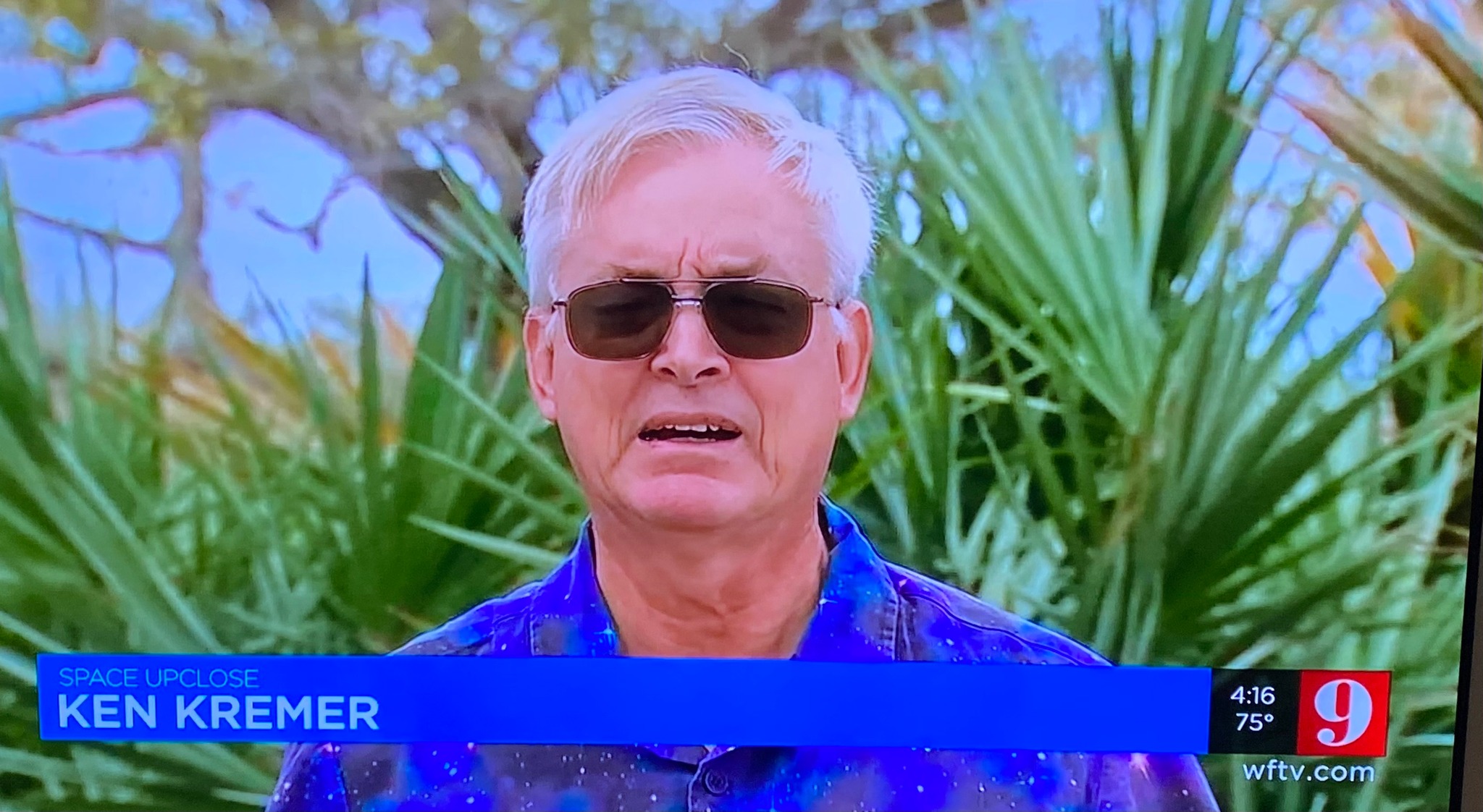
Watch Ken’s continuing reports about Artemis, SLS, Orion and NASA missions, JWST, IXPE, DART, Lucy Asteroid mission, GOES, SpaceX Cargo and Crew Dragons, SpaceX Starlink, Commercial Crew and Starliner and Crew Dragon, Blue Origin and Space Tourism, and onsite for live reporting of upcoming and recent SpaceX and ULA launches including Crew 1 & 2 & 3, ISS, Solar Orbiter, Mars 2020 Perseverance and Curiosity rovers, NRO spysats and national security missions and more at the Kennedy Space Center and Cape Canaveral Space Force Station.
Stay tuned here for Ken’s continuing Earth and Planetary science and human spaceflight news: www.kenkremer.com –www.spaceupclose.com – twitter @ken_kremer – email: ken at kenkremer.com
Dr. Kremer is a research scientist and journalist based in the KSC area, active in outreach and interviewed regularly on TV and radio about space topics.
………….
Ken’s photos are for sale and he is available for lectures and outreach events
Please consider supporting Ken’s work by purchasing his photos and/or donating at Patreon:
https://www.patreon.com/kenkremer

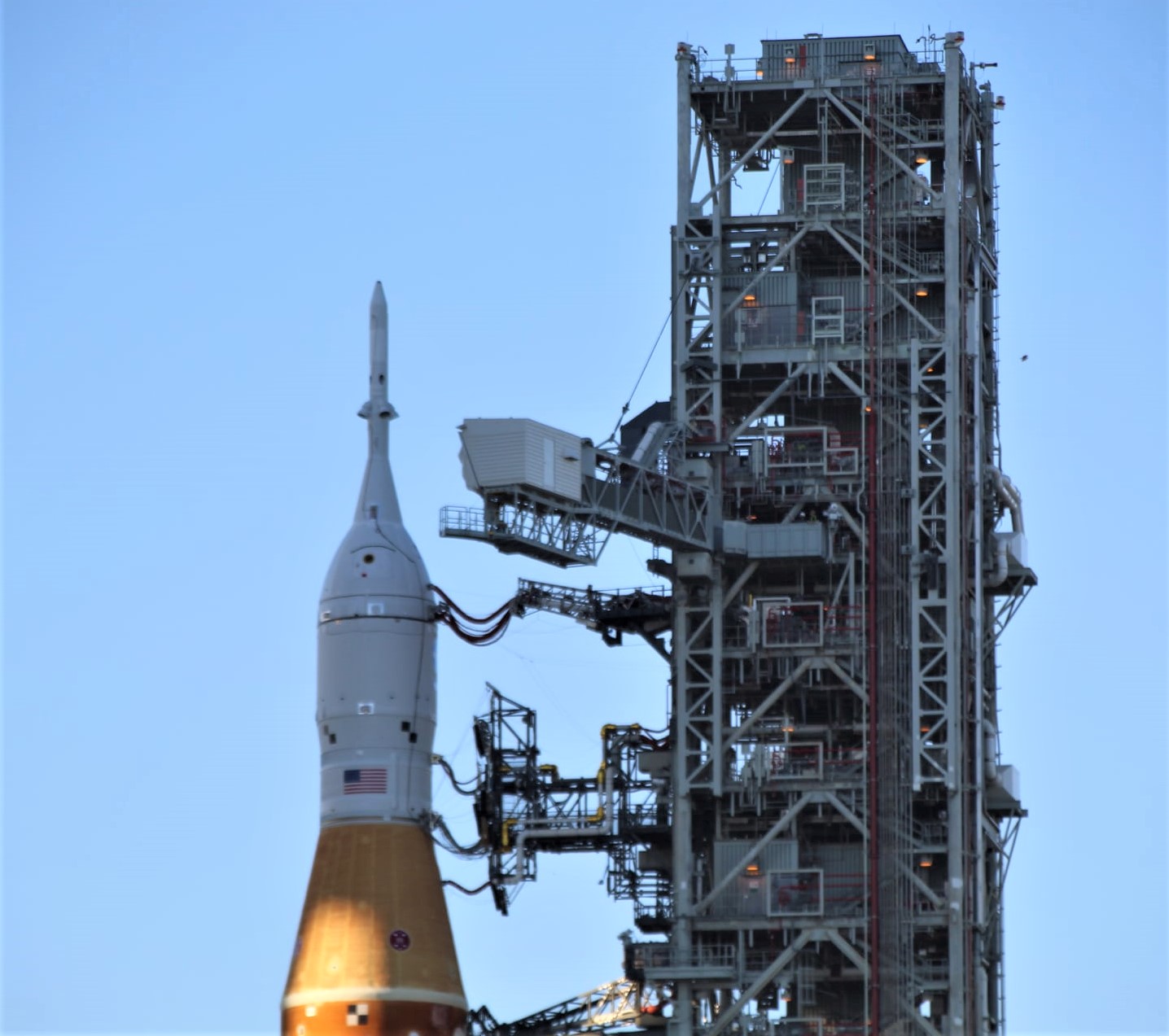
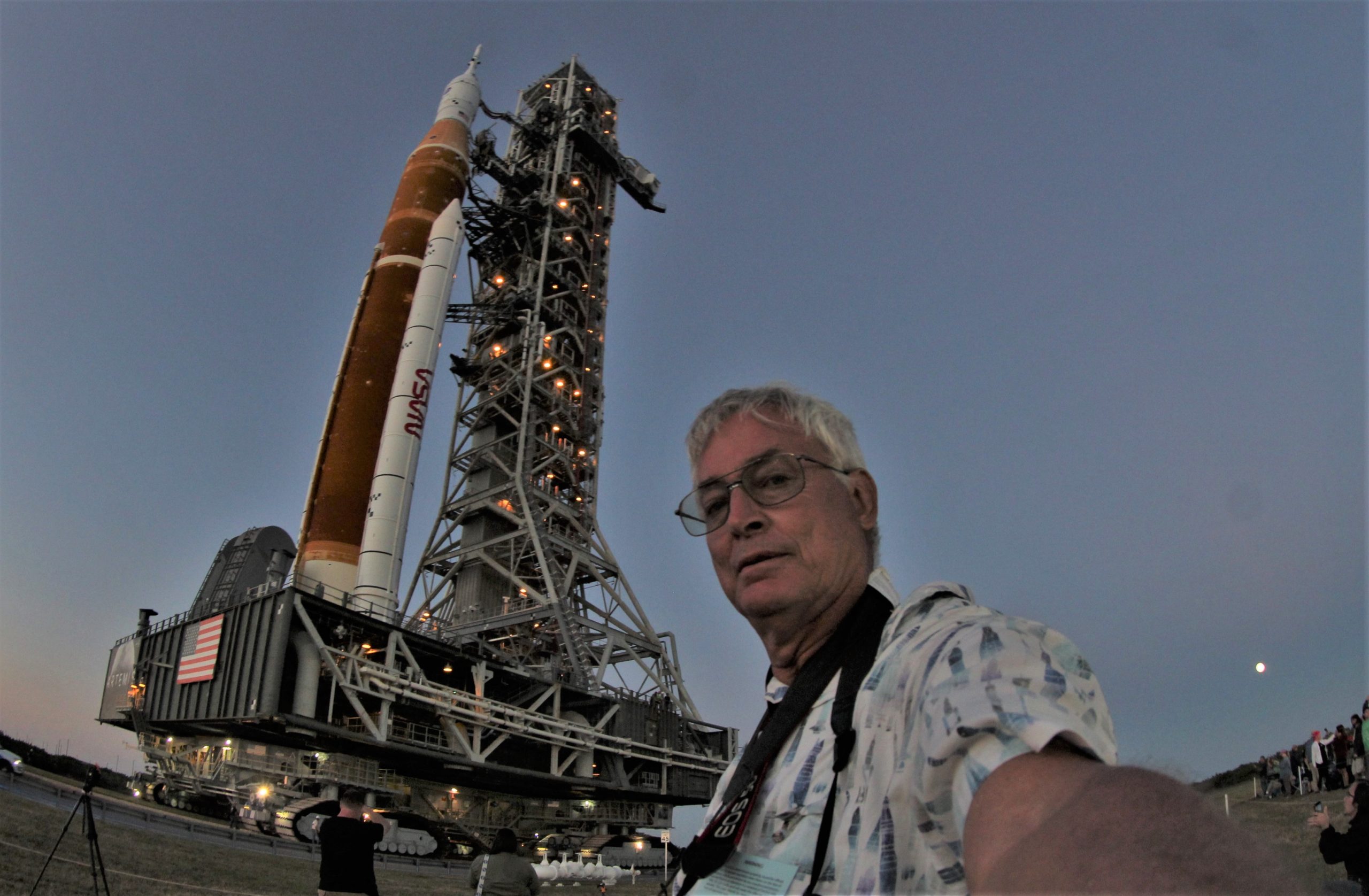
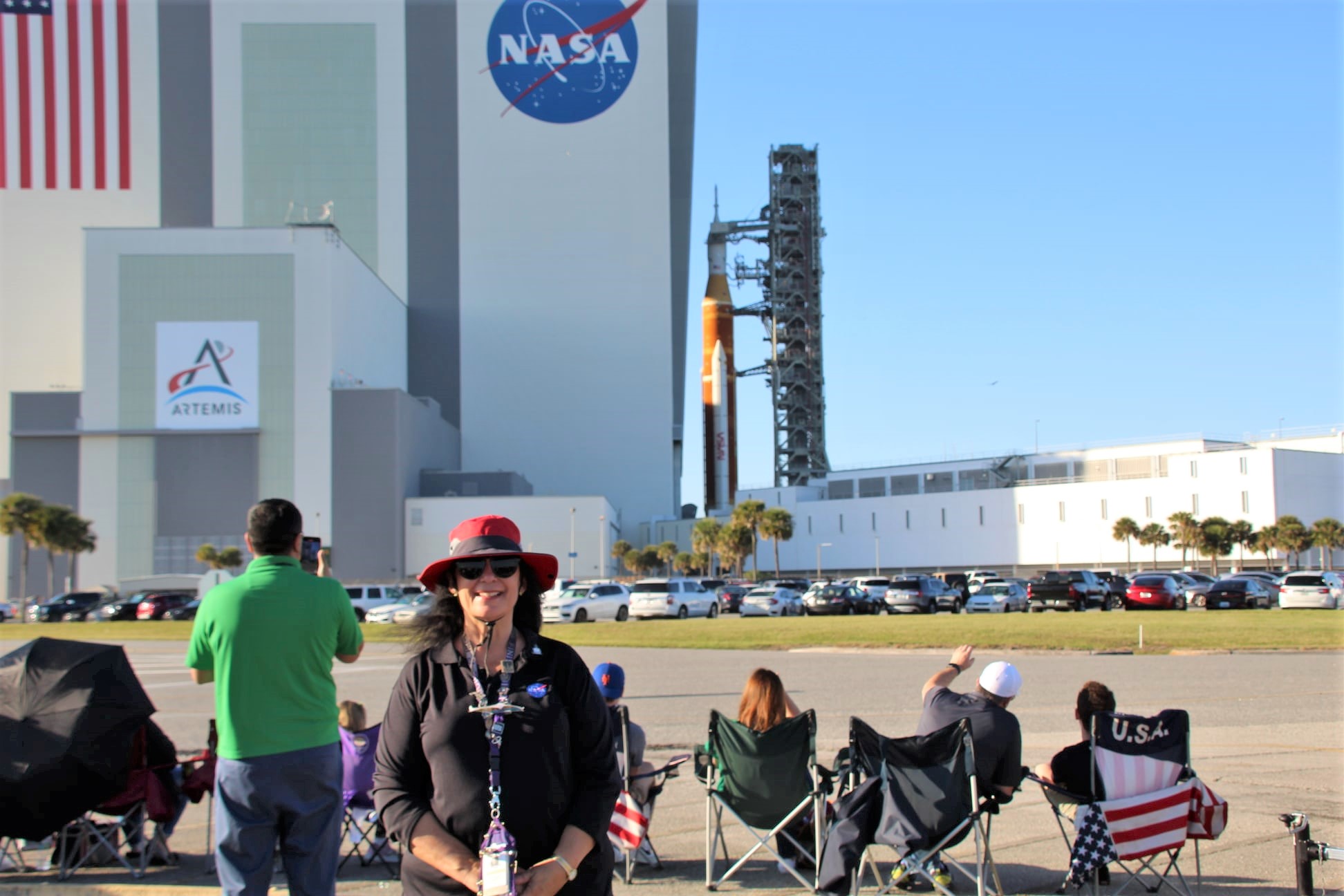
x



